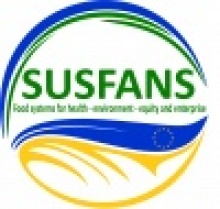Deliverable 11.2 Logo and Website
Abstract : This deliverable will report on Task 11.2. The project website, including the project logo and a SUSFANS community on LinkedIn, will have an external and internal structure. The website will offer completed research output as well as provide key data tha t will allow the user to interact with the research findings
Take a lookDeliverable 11 .1 Communication Plan
Abstract: This deliverable embodies the Communication Plan and will report on Task 11.1. The communication plan includes a long list of the future users of the SUSFANS toolbox and first clusters of regions and target groups
Take a lookDeliverable 8.2: Preliminary report on Task 8.2: prices forecasting model
We present a comprehensive modelling framework aimed at obtaining shortterm forecasts of commodity prices. The publication has been released to the consortium members
Take a lookDeliverable 8.1: The decomposition of agricultural commodity markets volatility between fundamentals and market speculation
We analyse the role played by market fundamentals, speculation and macroeconomic conditions as empirical determinants of commodity price changes. We combine model averaging techniques to explain historical patterns with an in-depth analysis of out-ofsample predictability of commodity prices using fundamentals as well as macroeconomic and financial variables. Our results indicate that variables related to global macroeconomic and financial developments contain valuable information to explain the historical pattern of coffee price developments, as well as to improve out-of-sample predictions of coffee prices.
Take a lookDeliverable 4.4: Preliminary report on Task 4.4: drivers of crop production
Crop production is the most crucial primary agricultural production activity for both food and nutrition security. Around 70% of the calories per capita and day come from plant-based products. Besides its importance for direct human consumption, crop production is also crucial for producing feed for livestock and aquaculture. The report provides a qualitative assessment of drivers of crop production and preliminary work for a quantitative analysis of crop production in the EU.
Take a lookDeliverable 4.2: The drivers of fisheries and aquaculture production in the EU
The role of seafood is complex in sustainable and nutritious diets. Production from c apture fisheries is limited whereas s eafood from aquaculture is seen as the most promising food production systems for the future. In this report, data on EU seafood production is provided, as well as a review of indirect and direct drivers for seafood produc tion in the EU. Several plausible directions for improved sustainability of seafood productio n in EU FNS are identified. Furthermore, metrics for environmental assessment of seafood in relation to EU policies on reduced environmental impacts are suggested .
Take a lookDeliverable 4.1: The drivers of livestock production in the EU
In the last decades the demand for animal source food (ASF) has increased. In response to a rising demand for ASF, animal numbers and animal productivity increased, due to science and technological developments. Currently we see that the demand for ASF is stagnating or decreasing due to socio-economic factors like environmental concerns, human health concerns and changing socio-cultural values (animal welfare). Given current high consumption levels of ASF in Europe, two main strategies can be followed to come to healthy and sustainable diets: reducing the impact of livestock production per kg of output by sustainable intensification, or improve human health and the environment by changing dietary patterns.
Take a lookDeliverable 2.4: Preliminary report on Task 2.4: lab experiment on consumers choice
This deliverable presents the results of the first experiment conducted in France. The second experiment that will be conducted in Italy, and the cosbenefit analysis will be presented in the final version of the report, under the deliverable 2.5. The paper has been released to the consortium members.
Take a lookDeliverable 2.2: Protocol for defining the nutritional adequacy of total diets and foods consumed in EU countries
Protocol for defining the nutritional adequacy of total diets and foods consumed in EU countries
Take a lookDeliverable 2.1: Consumers’ knowledge about the determinants for a sustainable diet
The deliverable will report on Task 2.1. Drawing on the results of a web-survey, it will discuss the importance of incorporating national and regional habits into metrics and models for the SFNS diet.
Take a lookDeliverable 1.2: Metrics to assess Sustainable Food and Nutrition Security in the EU - a progress report
Metrics to assess Sustainable Food and Nutrition Security in the EU -a progress report. Released to consortium.
Take a lookDeliverable 1.1: A Framework for Assessing and Devising Policy for Sustainable Food and Nutrition Security in EU: The SUSFANS conceptual framework
This deliverable reports on Task D1.1., the development of a conceptual framework for the SUSFANS project. Drawing on a literature review and feedback from the SUSFANS stakeholder core group, the conceptual framework describes the actors of the EU food system, their activities, the food system outcomes and the factors directly and indirectly driving actor behaviour. The framework also shows the relationships between the food system and the key policy goals the EU has formulated for the system. The report highlights the benefitsof adopting a food systems approach to analysing EU sustainable food and nutrition security and ends with describing the use of the conceptual framework within the project and externally
Take a look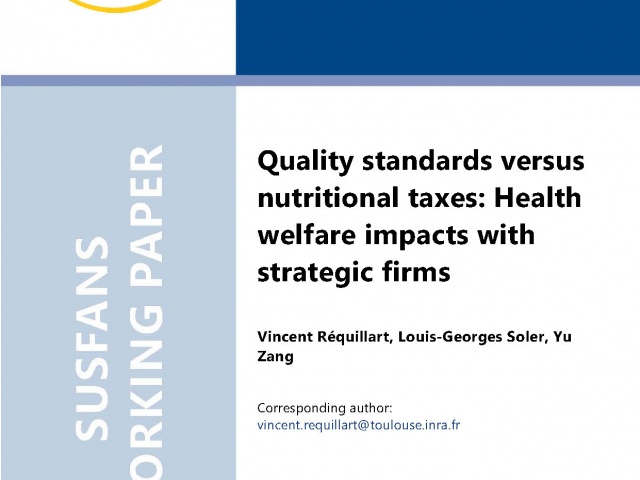
Quality standards versus nutritional taxes: Health welfare impacts with strategic firms
The goal of this paper is to better understand firms' strategic reactions to nutritional policies targeting food quality improvements and to derive optimal policies. We propose a model of product differentiation, taking into account the taste and health characteristics of products. We study how two firms react to alternative policies: an MQS policy, linear taxation of the two goods on the market, and taxation of the lowquality good. The MQS and the taxation of the low-quality product are the preferred options by a social planner. If taste is moderately important, the MQS policy is chosen by a populist and a paternalist social planner. If taste is a major component of choice, the populist planner chooses to tax the low-quality product whereas the paternalist planner prefers the MQS policy. Finally, for a paternalist social planner, an MQS-based policy always allows for higher levels of welfare than an information policy alone.
Take a look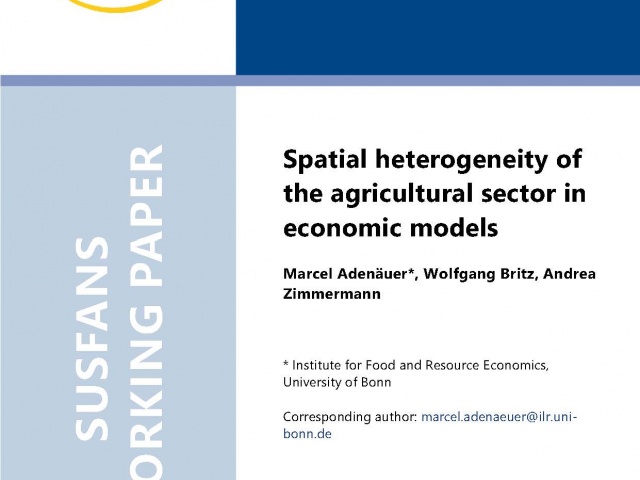
Spatial heterogeneity of the agricultural sector in economic models
Recent food price spikes and their potential link to biofuel and increased food demand (e.g. Ajanovic, 2011; Gilbert, 2010; Mueller et al., 2011; Piesse and Thirtle, 2009; Zilberman et al., 2012), on-going land use changes, such as conversion of tropical forest to agricultural land, and their relation to Green House Gas Emissions (cf. Harvey and Pilgrim, 2011) and discussions around the so-called bioeconomy (e.g. Hertel et al., 2013; Sheppard et al., 2011; Zilberman et al., 2013) all have renewed societal and scientific interest in better understanding how agricultural land use reacts to price and policy signals. Consequently, economic models working on quite different scales and being based on different methodologies were extended in recent years to better deal with land use and management issues.
Take a look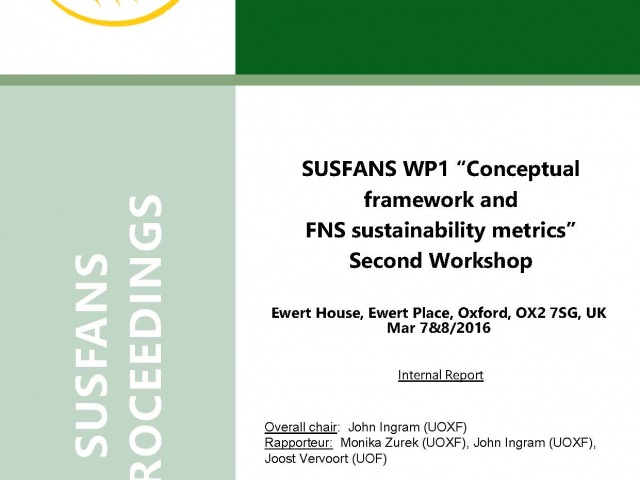
SUSFANS WP1 “Conceptual framework and FNS sustainability metrics” Second Workshop
Ewert House, Ewert Place, Oxford, OX2 7SG, UK Mar 7-8/2016 Overall chair: John Ingram (UOXF) Rapporteur: Monika Zurek (UOXF), John Ingram (UOXF), Joost Vervoort (UOF) The first part of the afternoon of Mar 7th was used to update meeting participants on the progress of the project since its beginning. After a welcome by John Ingram and a round of introductions, project coordinator Thom Achterbosch gave a presentation on project activities over the first year of the project and on the schedule of deliverables over the next year. These include two deliverables for WP1, namely a paper on the SUSFANS conceptual framework (D1.1) and on the metrics for assessing sustainable FNS (D1.2 and D1.3). Particularly the work on finalizing the metrics was the focus of this workshop.
Take a look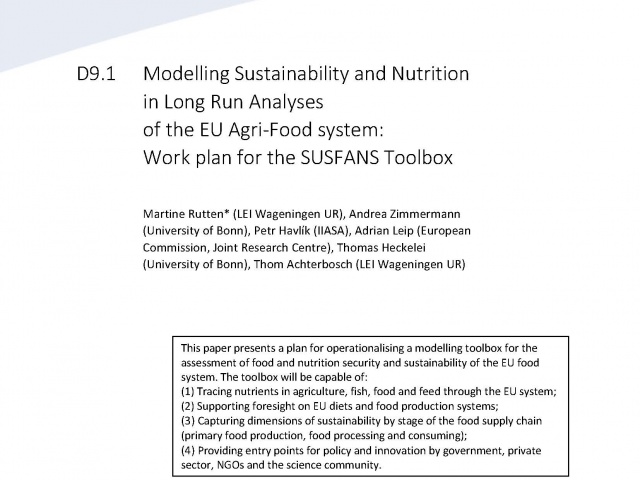
Deliverable 9.1: Modelling Sustainability and Nutrition in Long Run Analyses of the EU Agri-Food system: Work plan for the SUSFANS Toolbox
This paper presents a plan for operationalising a modelling toolbox for the assessment of food and nutrition security and sustainability of the EU food system. The toolbox will be capable of: (1) Tracing nutrients in agriculture, fish, food and feed through the EU system; (2) Supporting foresight on EU diets and food production systems; (3) Capturing dimensions of sustainability by stage of the food supply chain (primary food production, food processing and consuming); (4) Providing entry points for policy and innovation by government, private sector, NGOs and the science community.
Take a look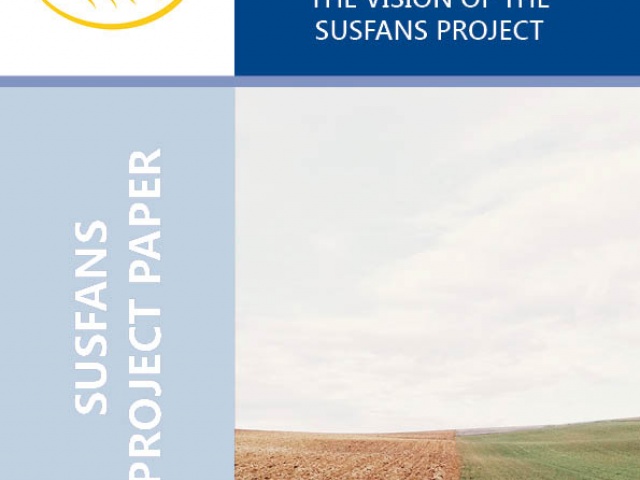
The vision of the SUSFANS project
This paper defines the research agenda of the SUSFANS project. It aims to contribute to balanced and encompassing views on how to strengthen food and nutrition security outcomes in the EU and how to improve the performance of the food system in the EU from the perspective of social, environmental and economic sustainability. The research is led by the notion that improvements in the diets of the European consumer must come from, and be supportive of, sustainable food systems. Its holistic, integrative approach builds a set of metrics, models and foresight tools, useable for navigation on sustainable food and nutrition security. It thereby results in a coherent and supported vision on what entails sustainable food and nutrition security in the EU and globally, and underpins a perspective on how EU policies on farming, fishing, food and nutrition could contribute to that vision with greater efficacy than today.
Take a look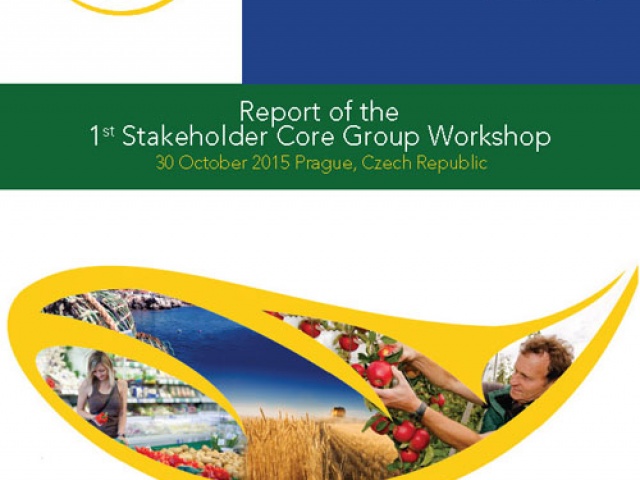
Report of the 1st Stakeholder Core Group Workshop
Report of the 1st Stakeholder Core Group Workshop with a summary of the Workshop and Stakeholder Recommendations. The first SUSFANS stakeholder workshop brought 42 participants together of which roughly 60% were representatives of different stakeholder groups and the rest researchers from the various research teams involved in the project. The stakeholder group was constituted of about a quarter of food system actors, such as primary producer and the food processing industry. The largest group of stakeholders present were so-called food system influencers such as civil society organization and advocacy groups working on food issues. In addition, a small number of EU policy makers (DG Research, DG Agri) joined the workshop.
Take a lookDeliverable 6.1: The SUSFANS Stakeholder Core Group, drawn across different sectors and roles in European FNS
Establishing a Stakeholder Core Group (SCG). A SCG of about 40 organisations will be convened, drawn from suggestions from all SUSFANS WP leaders. Balance across stakeholder communities, food systems areas, countries and gender will be paramount. This SCG will spearhead the stakeholder interaction across WPs 1-5, with WP11, and with other WPs as appropriate. Other members will therefore be co-opted as needed.
Take a look- ‹ previous
- 1
- 2
- 3
- 4
